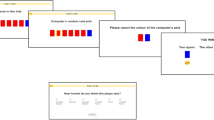Abstract
Bond and Uysal (this issue) complain that expert lie detectors identified by O’Sullivan and Ekman (2004) are statistical flukes. They ignore one class of experts we have identified and misrepresent the procedures we use to identify the others. They also question the psychometric validity of the measures and protocol used. Many of their points are addressed in the chapter they criticize. The fruitfulness of the O’Sullivan-Ekman protocol is illustrated with respect to improved identification of expert lie detectors, as well as a replicated pattern of errors made by experts from different professional groups. The statistical arguments offered confuse the theoretical use of the binomial with the empirical use of the normal distribution. Data are provided that may clarify this distinction
Similar content being viewed by others
References
Bond, C. F. Jr., & Uysal, A. (2007). On lie detection “wizards.” Law and Human Behavior, 31(1).
Bond, C. F. Jr., & Atoum, A. O. (2000). International deception. Personality and Social Psychology Bulletin, 26(3), 385–395.
Bond, C. F. Jr., & DePaulo, B. M. (in press). Accuracy of deception judgments. Personality and Social Psychology Review.
Burgoon, J. K., Buller, D. B., White, C. H., Afifi, W., & Buslig, A. L. S. (1999). The role of conversational involvement in deceptive interpersonal interactions. Personality and Social Psychology Bulletin, 25(6), 669–685.
Costa, P. T., & McCrae, R. R. (1985). The NEO Personality Inventory Manual. Odessa, FL: Psychological Assessment Resources.
Cronbach, L. J., & Shavelson, R. J. (2004). My current thoughts on coefficient alpha and successor procedures. Educational and Psychological Measurement, 64(3), 391–418.
De Groot, A. (1946/1978). Thought and choice in chess. The Hague: Mouton (Original work published 1946).
DePaulo, B. M., Lindsay, J. J., Malone, B. E., Muhlenbruck, L., Charlton, K., & Cooper, H. (2003). Cues to deception. Psychological Bulletin, 129(1), 74–118.
Ekman, P. (2001). Telling Lies: Clues to Deceit in the Marketplace, Politics, and Marriage (3rd ed.). New York: W. W. Norton.
Ekman, P., & Friesen, W. F. (1974). Detecting deception from the body or face. Journal of Personality & Social Psychology, 29(3), 288–298.
Ekman, P., & O’Sullivan, M. (1991). Who can catch a liar? American Psychologist, 46(9), 913–920.
Ekman, P., O’Sullivan, M., & Frank, M. G. (1999). A few can catch a liar. Psychological Science, 10(3), 263–266.
Embretson, S. E., & Reise, S. P. (2000). Item Response Theory for Psychologists. Mahwah, NJ: Erlbaum.
Ericsson, K. A. (2005). Recent advances in expertise research: A commentary on the contributions to the special issue. Applied Cognitive Psychology, 19, 233–241.
Ericsson, K. A., & Charness, N. (1994). Expert performance: Its structure and acquisition. American Psychologist, 49, 725–747.
Ericsson, K. A., & Simon, H. A. (1998). How to study thinking in everyday life: contrasting think-aloud protocols with descriptions and explanations of thinking. Mind, culture and activity, 5(3), 178–186.
Frank, M. G., & Ekman, P. (1997). The ability to detect deceit generalizes across different types of high-stake lies. Journal of Personality and Social Psychology, 72(6), 1429–1439.
Funder, D. (1999). Personality Judgment: A Realistic Approach to Person Perception. San Diego: Academic Press.
Gulliksen, H. (1950). Theory of Mental Tests. Oxford, UK: Wiley.
Ickes, W. (1993). Empathic accuracy. Journal of Personality, 61, 587–610.
Messick, S. (1995). Validity of psychological assessment: Validation of inferences from persons’ responses and performances as scientific inquiry into score meaning. American Psychologist, 50(9), 741–749.
Nunnally, J. C. (1978). Introduction to Psychological Measurement (2nd ed). New York: McGraw Hill.
O’Sullivan, M. (2003). The fundamental attribution error in detecting deceit: The boy-who-cried-wolf effect. Personality and Social Psychology Bulletin, 29(10), 1316–1327.
O’Sullivan, M. (2005). Emotional intelligence and detecting deception. Why most people can’t “read” others, but a few can. In Riggio, R. and Feldman, R. (Eds.), Applications of Nonverbal Communication (pp. 215–253). Mahway, NJ: Erlbaum.
O’Sullivan, M., & Ekman, P. (2004). The wizards of deception detection. In Granhag, P.A., & Strömwell, L. (Eds.), The Detection of Deception in Forensic Contexts (pp. 269–286). Cambridge, UK: Cambridge University Press.
Wechsler, D. (1958). The Measurement of Adult Intelligence (4th ed.). Oxford, UK: Williams and Wilkins.
Acknowledgments
Many thanks to Paul Ekman, Clark Freshman, Dana Carney, Shirley McGuire, Ben Lewis, Michael Davis-Wilson, Susan Heidenreich, David Howell, and Paul Zeitz for their comments on this response and the issues raised by it.
Author information
Authors and Affiliations
Corresponding author
About this article
Cite this article
O’Sullivan, M. Unicorns or Tiger Woods: Are Lie Detection Experts Myths or Rarities? A Response to On Lie Detection “Wizards” by Bond and Uysal. Law Hum Behav 31, 117–123 (2007). https://doi.org/10.1007/s10979-006-9058-4
Published:
Issue Date:
DOI: https://doi.org/10.1007/s10979-006-9058-4




